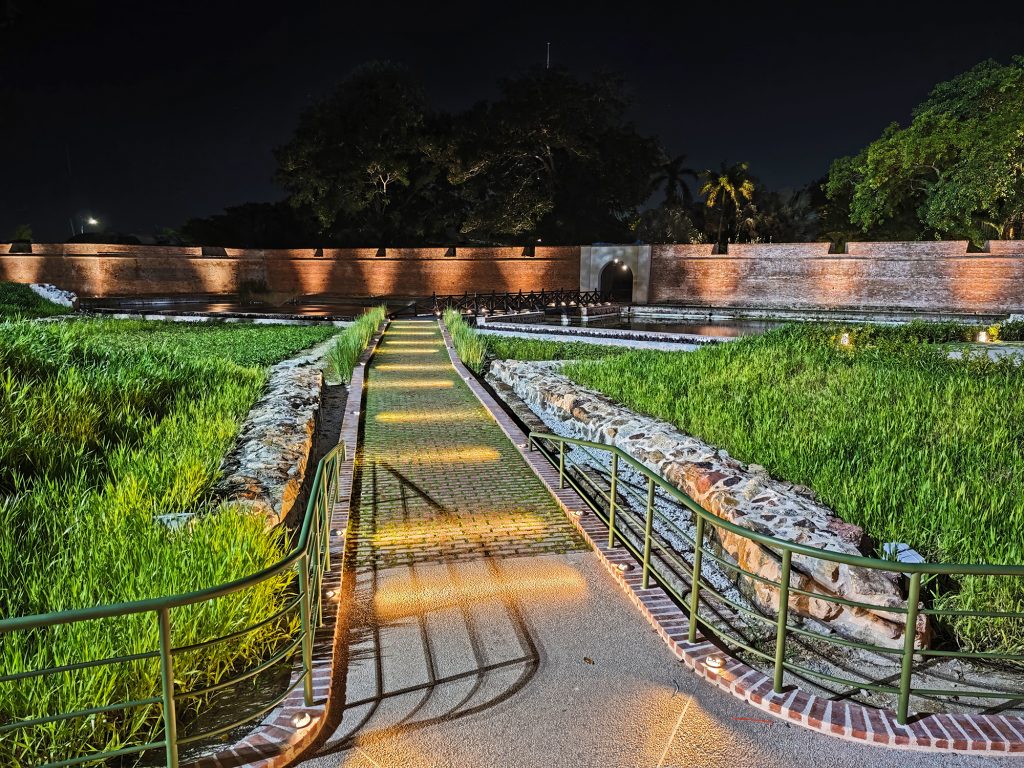
The newly restored western moat at Fort Cornwallis in George Town is set to reopen with an upgraded walkway and improved drainage, reviving a historical feature that once protected the 18th-century fort from invasions.

The newly restored western moat at Fort Cornwallis in George Town is set to reopen with an upgraded walkway and improved drainage, reviving a historical feature that once protected the 18th-century fort from invasions.
The newly restored western and southern moat at Fort Cornwallis at night. Together, both moats will form a water basin covering about 4,000 m², about 0.9 m deep, and holding roughly 3,600 cubic metres of water. The restoration uses traditional construction methods, with features like mechanical sand filters and bio-retention swales built into the design for ecological health and long-term stability. The project is part of Penang’s North Seafront Improvement Programme, with funding from the state government and partners like Think City and Yayasan Hasanah.
The Fort Cornwallis moat in Penang has undergone a major restoration set to be fully completed and opened to the public by July 2025, featuring the reinstatement of its southern and western sections to form a 4,000 square meter water basin about 0.9 meters deep, holding approximately 3,600 cubic meters of water. Using traditional building methods for long-term stability, the restoration includes ecological enhancements like a mechanical sand filter and a vegetated bio-retention swale, aligning with sustainable development goals. The project, costing around RM23.4 million and supported by the Penang state government, Think City, and Hasanah Foundation, also includes landscaping improvements, new visitor amenities, and a rebuilt food court adjacent to the moat, designed to complement the historic site.
This restoration revives the fort’s original defensive features from its 1804 construction, enhancing heritage conservation and turning the moat area into an attractive green public space and educational site for both locals and tourists, particularly timed to coincide with the George Town UNESCO World Heritage celebrations.
Originally constructed by the British East India Company in 1804 as a defensive measure during the Napoleonic Wars, the moat was filled in 1921 due to public health concerns (malaria) and construction developments.

Part of the historical Fort Cornwallis wall at the Esplanade.
A cannon at the walls of Fort Cornwallis in the Esplanade, George Town.
This historical lighthouse is one of the oldest lighthouses in Malaysia and is located within the Fort Cornwallis, George Town. It was built in 1882 during the British administration, and was known as the Fort Point Lighthouse back then.

The Fort Cornwallis is the largest remaining British fort in Malaysia. The largest cannon located at the seafront corner of the fort, known as Seri Rambai Cannon, was a gift from the Dutch to the Sultan of Johore
Built during the British rule, Fort Cornwallis is the largest fort still remaining in Malaysia. This old star-shaped fort is situated at the north-eastern side of Penang island. The fort is named after Charles Cornwallis, 1st Marquess Cornwallis who was the Governor General of Bengal, India in the late 18th century.
Captain Sir Francis Light took possession of the island from the Sultan of Kedah in 1786 and built the original fort. It was a nibong (Malay: palm trunk) stockade with no permanent structures, covering an area of 417.6 square feet (38.80 m2). Despite the fort’s original purpose to serve the Royal artillery troops and the military, historically it was more for administrative purpose than defensive.